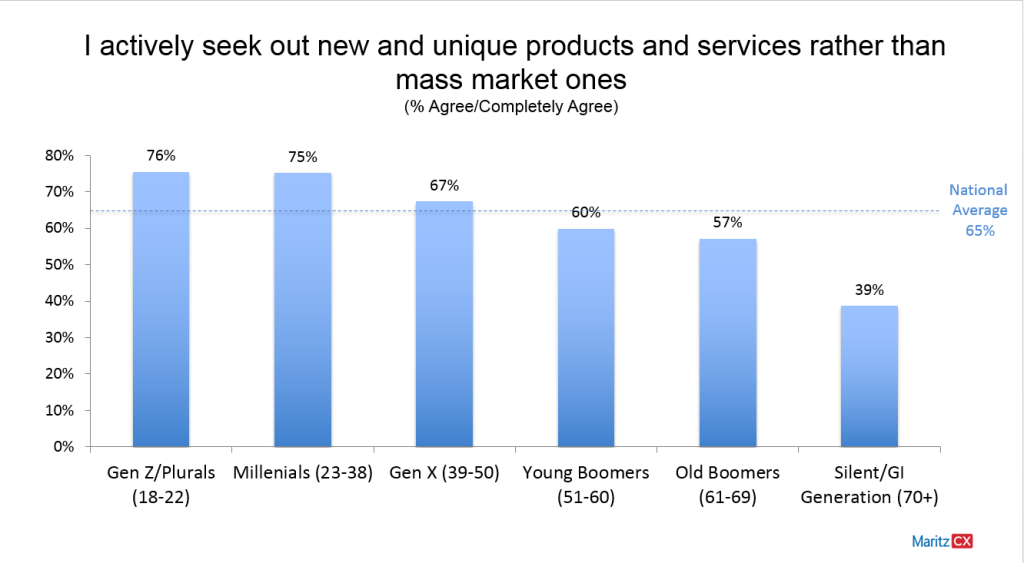Editor’s note: Dave Fish is responsible for global marketing and product development for Maritz Research, St. Louis. This is an edited version of a post that originally appeared here under the title, “It’s not you, it’s me. The quiet breakup with mass market.”
If he were alive today, Henry David Thoreau might breathe a sigh of relief at having made it to today through the greed and materialism of the late 20th century. Simpler living, individualism, localization, thrift and respect for the environment have made an incredible resurgence in recent years. Words such as “curated” and “craft” have become code words for high quality and holding respect for one’s own body and the environment. Also, I have noticed lots of guys with wicked large beards.
There is a latent but powerful revolution going on. It’s a quiet war against the mass market and it is making large corporations very nervous. Consumers are gradually breaking up with large, established brands and choosing local and personalized products instead. Younger generations want the unique and the different. According to a study I recently conducted, 75 percent of Millennials said that they actively seek out new and unique products and services, eschewing mass market options. Traditional claims such as best-selling and most popular may actually be hurting brands, as more and more consumers regard big as bad, and smaller niche players are becoming hugely popular. People don’t want what everyone else has anymore. They want something special. Finding that one-of-a-kind tweed bow tie in the bargain bin at Plato’s Closet sends chills down the modern hipster’s spine.
Younger generations also want local. According to our research, 50 percent of Millennials prefer shopping exclusively at smaller, locally-based stores rather than at huge mega-marts. It would seem that, once again, human beings might want to live in small villages while still getting the convenience of giant metros. The long tail of technology makes this possible. Companies like Etsy provide a storefront for extremely small businesses to sell unique products. Kickstarter is an entrepreneur’s playground and a consumer’s dream world of possibilities. The rise of home delivery options makes getting stuff easy and fun.
Recently, Fortune published a special edition on the war on big food as people move toward smaller niche brands rather than traditional CPG stalwarts. The evidence is ubiquitous. We went from 199 breweries in 1988 in the United States to over 3,400 today, most of them regional microbreweries. People want craft. People want unique.
There is a zeitgeist of entrepreneurship underwriting this trend; young start-ups are taking aim at mature industries and throwing dynamite at long held beliefs of “how it should be.” Mobility, data promiscuity and the low cost of storage are all making success possible for even the smallest of players.
Let’s take a look at mobility. Today, more people are checking their email on a mobile device than at their laptop or desktop. Wearable technology is creating an increasingly cozy cybernetic relationship with us on a day-by-day basis. Buying mobile capability is easier than ever.
To say that data is everywhere is understatement. Not only is it everywhere but young people are, by and large, more open to sharing it than ever. According to our research, 38 percent of those under 22 state they are happy to share their information as long as they get something in return. Think about Facebook. Nineteenth-century Catholic priests would tremble and cry at the prospect of gaining access to the data that people volunteer on Facebook versus what can be obtained in confessional. I can find out on your profile your political affiliation, your favorite food, where you’ve been, what books you read, who you are talking to, your romantic status and even if you are taking Lent seriously.
Finally, storage is cheap. The cost of one terabyte of storage in 1980 was more than $400,000. Today it costs three cents. On average, every 14 months that cost is halved again. That allows us to record, store and retrieve a lot of stuff for a ridiculously low cost. So there’s that.
With those three trends in the quiver, small start-ups are taking aim at venerable and slow-moving industries. Health care, CPG, retail, travel, hospitality, utilities, automotive, financial service, insurance … no one can hide from this technology-fueled, neo-Walden disruptive inquisition. In fact, the bigger and slower, the better the target. Even quasi-governmental agencies can’t escape.
To their credit, established corporations are responding. In a rush to get local and organic, juggernaut General Mills bought Annie’s Organic Mac-n-Cheese. There is wide speculation that either Delta or American will try and purchase the revered, customer-focused and local Alaska Airlines. Burt’s Bees was acquired for $1 billion by the corporate giant Clorox. Colgate-Palmolive bought out hippy-infused darling Tom’s of Maine. The list goes on and on. I’m not convinced that consumers, especially Millennials, are buying it though.
What is your organization doing about this? Are you leading the charge to blow stuff up, or are you hankering down and hoping it all goes away? The latter never seems to work. Perhaps it is best to take Mr. Thoreau’s advice and “go confidently in the direction of your dreams.” Think of what you and your organization can do to think local, personalized and agile. Imagine being the guy or the gal after the break up with mass market. That’s a good place to be.

